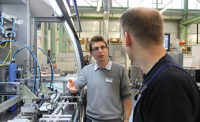Depending on the drive style, a high-tonnage mechanical press can stamp out metal parts at up to 1,000 strokes per minute. Even so, it’s a remarkably durable machine. The steel frame will long outlive the motor and electronic controls that drive the flywheel.
And therein lies a problem. Most mechanical presses built in the 1980s or earlier were powered by DC brush motors. And they are expensive and difficult to replace, retune and maintain. A new DC motor can take weeks to get. Once installed, it must be tuned with potentiometers and jumpers. The process requires considerable tweaking, even if the original motor’s “pot” settings are known.
“We have several customers where engineers used a paint marker to note how the potentiometers were set,” says Steve Spero, service engineer with Yaskawa America Inc. “We have other customers where no one knew how they were set, and it can be all sorts of fun turning those knobs to get the motor back in working condition.”
To avoid such issues, a growing number of manufacturers are using AC motors to replace DC motors in mechanical presses, transfer systems, extruders, slitters, cutters, feeders, winding machines and other equipment.
Compared with DC motors, AC motors offer many advantages. For one thing, AC motors are readily available from numerous manufacturers, including Baldor and Marathon Electric. And, of course, AC motors have no brushes to wear out or commutators to rewind.
More importantly, today’s digital drives, like the A1000 from Yaskawa, vastly simplify the process of configuring and maintaining AC motors. Rather than tweak a series of “pots,” engineers simply enter the motor’s operating parameters via a keypad, laptop or digital network, such as DeviceNet, Ethernet or CC-Link.
“You can back-up all the parameters, so if you lose a drive, it’s easy to restore them and get back up and running,” says Dave Cecil, Yaskawa’s director of engineering and service.
The A1000’s keypad interface has application presets to make programming simple, and it has built-in memory for backup purposes. In addition, a USB copy unit can be plugged into the drive so configuration information can be transferred between an office environment and the factory floor.
“If you lose a drive, you can unplug the keypad, put in a new drive, reinstall the keypad, and it will automatically download the parameters,” explains Cecil. “If you had 10 identical presses, you could take that keypad from press to press and download the parameters.”
The drive’s removable I/O terminal board also provides backup memory for the drive. All parameter changes are automatically saved to both the main control board and I/O board. Engineers can leave the I/O connected when replacing a drive—configuration information will download automatically to the replacement.
The A1000 has several features to simplify preventive maintenance. The cooling fans snap in and out for easy replace-ment. Onboard monitors track drive temperature, precharge relay, and the remaining life of the cooling fan, bus capacitor and insulated gate bipolar transistors. The drive can use this information to trigger alarms or send status reports to managers across a network.
“There are also monitors on the drive that electronically look at the output current, output voltage, DC bus voltage and other variables without having to hook up an analog meter,” says Spero. “You just push a button, and there it is.”
“A lot of companies are moving to a ‘predictive failure’ philosophy,” adds Cecil. “The idea is to predict when the drive will fail. Instead of waiting until the drive breaks, you look for indicators that it’s getting ready to break and take action be-fore it fails and causes downtime.”
XYZ: AC Motors vs. DC Motors for Power Presses

Most mechanical presses built before 1990 were powered by DC brush motors. When the time comes to replace the motor, manufacturers are increasingly switching to AC motors and digital drives, like the A1000. Photos courtesy Rajesh Press Systems and Yaskawa America Inc.

Most mechanical presses built before 1990 were powered by DC brush motors. When the time comes to replace the motor, manufacturers are increasingly switching to AC motors and digital drives, like the A1000. Photos courtesy Rajesh Press Systems and Yaskawa America Inc.

